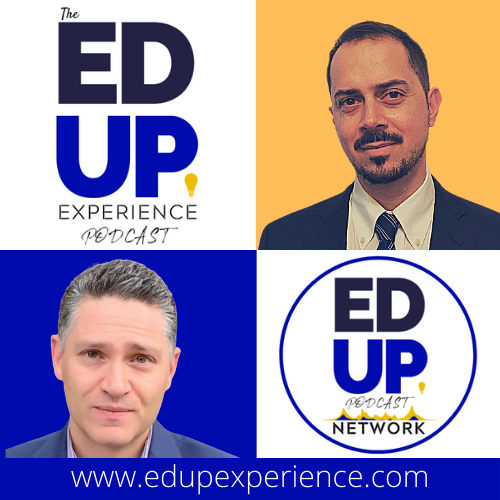Published on
Everybody Is a Prospective Student

In today’s emerging new normal, higher education is filled with a variety of students—from traditional to non-traditional. But non-traditional students are becoming the majority demographic, and institutions need to adapt old marketing practices to attract and retain the modern learner. In this interview, Dr. Joe Sallustio talks to Jamal Scott about understanding the student lifecycle, adapting to change and what the future of higher education looks like.
EdUp Experience: Do you think it’s important to future growth to understand the full student lifecycle and track data?
Jamal Scott (JS): My role has really changed over the last few years. I didn’t have admissions right away. But as we began to grow as a college and we looked at how to leverage each other’s experiences and backgrounds to be more effective, I added admissions to this portfolio a few years ago. You can really look now more holistically at how we’re branding ourselves, how we’re attracting students, what messaging we use and what it is that all of our students are looking for. From the high school level to the adult level, we’re really trying to come up with programs and services that cater to all aspects of our community.
One of the great things about a community college is that everybody is a prospective student. Whether you’re coming out of high school, you’ve been working for a while and want to get retrained or you’re a stay-at-home parent looking to jump back into the workforce. We partner with the Lifelong Learning Institute to develop programs and services for some of our older community members.
We’re very consistent with gathering data. We go out every year and do brand pulse studies and community needs assessments. And we heard about four years ago that our community didn’t know us as well as we thought they did. The brand was strong, but the awareness of some of our programs and services was not as strong as we’d hoped. Just having all that information at my disposal has really helped us strategize more effectively and better serve our community.
EdUp Experience: As a leader in effecting change within your organization, what are some of the ways that higher ed can be better at adapting to change?
JS: I got some advice from a guy at the Dallas Morning News who spoke at AFIT a while ago. He said, “If you’re not changing your organization every year, you’re going to fall behind.” And I remember that 90% of their business was print but he was saying, “We’re preparing for the inverse, for maybe one day with the way technology is changing, then 90% of it could be it electronic.” In higher ed, we’re very traditional in a lot of ways, with structures that were maybe set up 30 or 40 years ago. And because we’ve always done it that way we maintain these structures, and we don’t look at how we should shape them for today.
Last year, we heard from a gentleman at the Air Force who talked about cleaning the old whiteboard and saying, “If we were designing the Air Force today, what would it look like?” We have to do that in higher ed. We can’t think about how we’ve been structured for the last 30 or 40 years. We have to think about the needs of our constituents, our students, today. We don’t like to think of students as customers—we think that’s a sales word—but that’s exactly what they are. People today have more options than ever before.
Higher education’s value proposition needs strengthening. We have to be able to tell a family why they should spend money on our institution. Coming here to learn and have a great experience is no longer a sufficient value proposition. For years, the community college is the low-cost game in town. Well now, four-year schools are being more aggressive. And just like anything, we’ll pay more for something if we perceive it to be of greater value. In higher ed, we have to make sure, especially at the community college, that we’re strengthening that value proposition.
EdUp Experience: How can we reframe our state of mind to be more focused on students’ needs?
JS: You need some intentionality behind your research. You have to go out and talk to students. We’ve been doing focus groups on a monthly basis, and we come up with different topics based on the things that we’re trying to plan and strategize for. We want students in the room. You have to have them on your committees. You want to go into the community. You have to talk to people who are not yet a part of your college or university and say, “Hey, if we were going to build this structure, program or system, what would be attractive to you?”
We have talked to students who have applied but never started and asked them, “Hey, why did you choose not to come to school here? What were some things that we could have done better?” And we conduct feedback surveys on the backend. It’s important to gather as much data and information as you can while keeping the student front and center.
It’s just being about very specific and being intentional about getting this feedback. Then most importantly, taking what you learn and making change based on it, closing the feedback loop.
EdUp Experience: Do you think we need to learn to trust the student more?
JS: We don’t like to think of ourselves as constructing or running a business model. For example, I heard from the vice president of marketing for Kraft about how, before they put out new products, they test them and prototype them for two or three years. Before we see it in Target, they’ve been testing it for the last three years, asking whether it’s the right cheese, how it tastes.
They ask questions, refine, prototype, iterate and plan things out before taking them to market. In higher ed, we have to continue to do more of that. We’ve tried doing somewhat in non-credit, using it as a little bit of a programmatic incubator. Before you spend thousands of dollars rolling out a program, maybe test it on the community, talk to some people. If we were going to offer this as a credit or as a degree program, what are some things we should think about? And do you think this would work? It’s about making an effort to get feedback and being open to listening to what you hear. It may not be what you like, but if this is what the students, community members and customers are telling you is going to work and what piques their interest, you have to take that feedback and change your program accordingly.
EdUp Experience: What your big takeaways for your institution?
JS: One of the biggest value propositions for AFIT is again, just hearing from businesses and industries and professionals outside of higher education. That was so important. This week we heard from companies and learned that you need to have the ability to tell your story. What is your organizational story? What is your value proposition? What is the why? What are you good at? What are you working on?
You have to have the recipient in mind when you’re constructing and telling your story. If you’re talking to a group of people or to an audience, what do you want them to take away? What do you want them to leave knowing about your organization? And there are so many ways we do that. We do that now through social media and still though print communications. We do that when we’re out.
In terms of innovation, what are you going to change? You have to break down these hierarchical structures and tradition. There’s an element of tradition that’s good. You want to keep what made your organization what it is, but you have to grow and innovate with the time. If you could break something, how would you break it and fix it? But also, don’t be afraid to play and have fun. It’s important to do that because that breaks down walls of defensiveness. And if you can spend a couple days having a good time with somebody, a couple weeks later when you have to have a challenging conversation, maybe you’re not quite as cynical. Maybe you trust their intentions a little more and maybe the outcome of that conversation will be better.
EdUp Experience: Is there anything that you’d like to add?
JS: We are like every other organization—we are working on quite a few things. Looking at our strategic plan this year, we’re focused on student equity and success. That’s one of our big pillars. We are a Hispanic-serving institution. We received our third consecutive Title V grant from the Department of Education. We’re starting a Latinx resource center for our Hispanic and Latino communities at our downtown Aurora campus. We’re looking at some new student service delivery models and trying to find ways to create a dynamic student experience. It’s about learning in the classroom, but it’s also so about enjoying yourself while you’re on campus.
We have a workforce and solutions council made up many municipal partners and the Illinois Department of Employment Security and a few others. And we’re continuing to work with that group to identify ways to provide answers to some of the problems they’re having. From an employee standpoint, we’re still focused on employees’ future technological needs.
We want to be the top choice for learning in our community and an employer of choice. We’re really, really excited about some of the things we have going on here.
EdUp Experience: What does the future of higher education look like?
JS: We just have to continue to be flexible, pivot quickly, break down the walls of tradition and be unafraid to try new things. You need to be willing to jump out and say, “We’re going to give this a shot. We’re not sure if it’s going to work, but we’re going to plan, we’re going to prepare and we’re going to jump out there and try it.” That’s how you iterate and prototype. That’s how you perfect things—by getting out there and trying it. That’s going to be important for higher education.
We found a lot of success with synchronous online modality. Traditionally students come to the classroom, sit down, learn. Well, now we’re finding that students love learning the same way we’re talking here on Zoom. We can share documents. We can see each other. It’s in real time, and I don’t have to worry about transportation, childcare or getting something to eat while I’m out. A lot of the roadblocks and the barriers that may have prevented students from going to school, even at a community college level, are eliminated when they can learn in a synchronous online manner. Continuing to look at different modalities of learning, the proliferation of technology and all these platforms we have now are going to make learning a lot easier and more accessible for students.
This interview was edited for length and clarity.
Listen to the full interview here.

Author Perspective: Administrator


